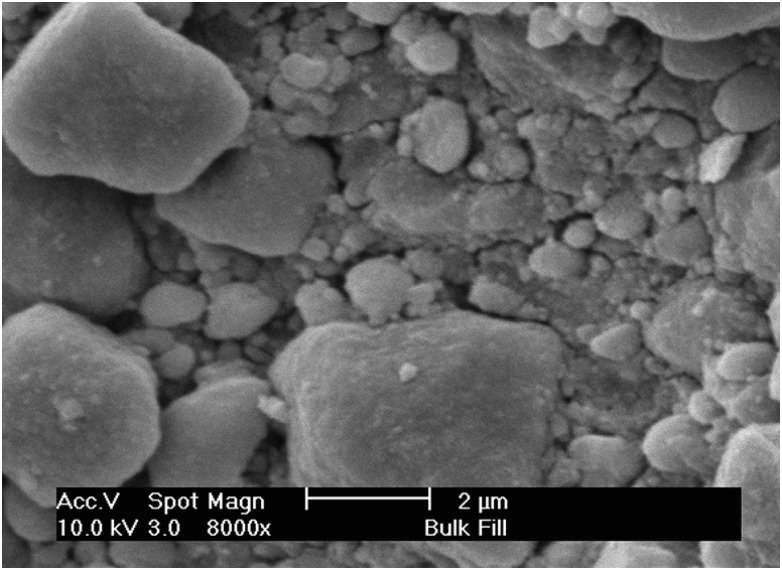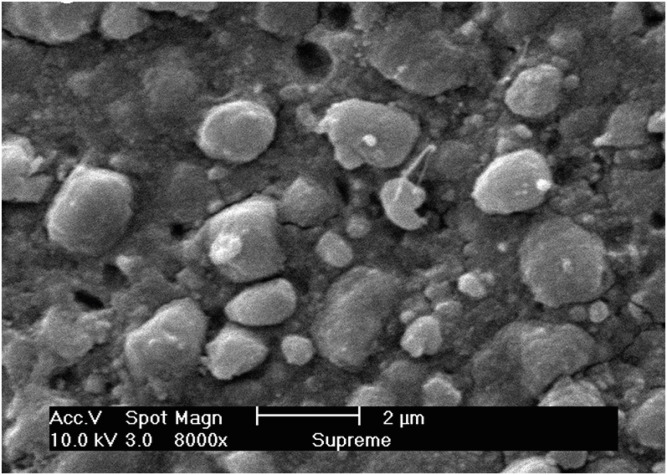Restor Dent Endod.
2020 Aug;45(3):e32. 10.5395/rde.2020.45.e32.
The polymerization efficiency of a bulk-fill composite based on matrixmodification technology
- Affiliations
-
- 1Oral Technology, School of Dentistry, University of Bonn, Bonn, Germany
- 2Dental Biomaterials Department, Faculty of Dentistry, Alexandria University, Egypt
- 3Biomaterials Department, Faculty of Dentistry, Ain Shams University, Cairo, Egypt
- KMID: 2512023
- DOI: http://doi.org/10.5395/rde.2020.45.e32
Abstract
Objectives
To evaluate the polymerization efficiency of a matrix-modified bulk-fill composite, and compare it to a conventional composite which has a similar filler system. The degree of conversion (DC%) and monomer elution were measured over different storage periods. Additionally, fillers' content was examined.
Materials and Methods
Cylindrical specimens were prepared, in bulk and incrementally, from Filtek Bulk Fill (B) and Filtek Supreme XTE (S) composites using a Teflon mold, for each test (n = 6). Using attenuated total reflection method of Fourier transformation infrared spectroscopy, DC% was measured after 24 hours, 7 days, and 30 days. Using high-performance liquid chromatography, elution of hydroxyethyl methacrylate, triethylene glycol dimethacrylate, urethane dimethacrylate, and bisphenol-A glycidyl dimethacrylate was measured after 24 hours, 7 days and 30 days. Filler content was examined by scanning electron microscopy (SEM). Data were analyzed using 2-way mixed-model analysis of variance (α = 0.05).
Results
There was no significant difference in DC% over different storage periods between B-bulk and S-incremental. Higher monomer elution was detected significantly from S than B. The elution quantity and rate varied significantly over storage periods and between different monomers. SEM images showed differences in fillers' sizes and agglomeration between both materials.
Conclusions
Matrix-modified bulk-fill composites could be packed and cured in bulk with polymerization efficiency similar to conventional composites.
Figure
Reference
-
1. Sgarbi SC, Pereira SK, Martins JM, Oliveira MA, Mazur RF. Degree of conversion of resin composites light activated by halogen light and led analyzed by ultraviolet spectrometry. Arch Oral Res. 2010; 6:223–230.2. Schwengberg S, Bohlen H, Kleinsasser N, Kehe K, Seiss M, Walther UI, Hickel R, Reichl FX. In vitro embryotoxicity assessment with dental restorative materials. J Dent. 2005; 33:49–55. PMID: 15652168.3. Halvorson RH, Erickson RL, Davidson CL. Energy dependent polymerization of resin-based composite. Dent Mater. 2002; 18:463–469. PMID: 12098575.
Article4. Cramer NB, Stansbury JW, Bowman CN. Recent advances and developments in composite dental restorative materials. J Dent Res. 2011; 90:402–416. PMID: 20924063.
Article5. Frauscher KE, Ilie N. Depth of cure and mechanical properties of nano-hybrid resin-based composites with novel and conventional matrix formulation. Clin Oral Investig. 2012; 16:1425–1434.
Article6. Atai M, Ahmadi M, Babanzadeh S, Watts DC. Synthesis, characterization, shrinkage and curing kinetics of a new low-shrinkage urethane dimethacrylate monomer for dental applications. Dent Mater. 2007; 23:1030–1041. PMID: 17493674.
Article7. Ganster B, Fischer UK, Moszner N, Liska R. New photocleavable structures. Diacylgermane-based photoinitiators for visible light curing. Macromolecules. 2008; 41:2394–2400.
Article8. Kerby RE, Knobloch LA, Schricker S, Gregg B. Synthesis and evaluation of modified urethane dimethacrylate resins with reduced water sorption and solubility. Dent Mater. 2009; 25:302–313. PMID: 18799211.
Article9. Kloxin CJ, Bowman CN. Covalent adaptable networks: smart, reconfigurable and responsive network systems. Chem Soc Rev. 2013; 42:7161–7173. PMID: 23579959.
Article10. Bowman CN, Kloxin CJ. Covalent adaptable networks: reversible bond structures incorporated in polymer networks. Angew Chem Int Ed Engl. 2012; 51:4272–4274. PMID: 22389302.
Article11. Rothmund L, Reichl FX, Hickel R, Styllou P, Styllou M, Kehe K, Yang Y, Högg C. Effect of layer thickness on the elution of bulk-fill composite components. Dent Mater. 2017; 33:54–62. PMID: 27836116.
Article12. Alshali RZ, Salim NA, Satterthwaite JD, Silikas N. Long-term sorption and solubility of bulk-fill and conventional resin-composites in water and artificial saliva. J Dent. 2015; 43:1511–1518. PMID: 26455541.
Article13. Orłowski M, Tarczydło B, Chałas R, Renata C. Evaluation of marginal integrity of four bulk-fill dental composite materials: in vitro study. Sci World J. 2015; 2015:701262.14. Ilie N, Keßler A, Durner J. Influence of various irradiation processes on the mechanical properties and polymerisation kinetics of bulk-fill resin based composites. J Dent. 2013; 41:695–702. PMID: 23707645.
Article15. Lempel E, Czibulya Z, Kovács B, Szalma J, Tóth Á, Kunsági-Máté S, Varga Z, Böddi K. Degree of conversion and BisGMA, TEGDMA, UDMA elution from flowable bulk fill composites. Int J Mol Sci. 2016; 17:732.
Article16. Li X, Pongprueksa P, Van Meerbeek B, De Munck J. Curing profile of bulk-fill resin-based composites. J Dent. 2015; 43:664–672. PMID: 25597265.
Article17. Par M, Gamulin O, Marovic D, Klaric E, Tarle Z. Effect of temperature on post-cure polymerization of bulk-fill composites. J Dent. 2014; 42:1255–1260. PMID: 25132366.
Article18. Alshali RZ, Silikas N, Satterthwaite JD. Degree of conversion of bulk-fill compared to conventional resin-composites at two time intervals. Dent Mater. 2013; 29:e213–e217. PMID: 23845799.
Article19. Leprince JG, Leveque P, Nysten B, Gallez B, Devaux J, Leloup G. New insight into the “depth of cure” of dimethacrylate-based dental composites. Dent Mater. 2012; 28:512–520. PMID: 22217607.
Article20. Zorzin J, Maier E, Harre S, Fey T, Belli R, Lohbauer U, Petschelt A, Taschner M. Bulk-fill resin composites: polymerization properties and extended light curing. Dent Mater. 2015; 31:293–301. PMID: 25582061.
Article21. Durner J, Obermaier J, Draenert M, Ilie N. Correlation of the degree of conversion with the amount of elutable substances in nano-hybrid dental composites. Dent Mater. 2012; 28:1146–1153. PMID: 22940188.
Article22. Czasch P, Ilie N. In vitro comparison of mechanical properties and degree of cure of bulk fill composites. Clin Oral Investig. 2013; 17:227–235.23. Sharma S, Padda BK, Choudhary V. Comparative evaluation of residual monomer content and polymerization shrinkage of a packable composite and an ormocer. J Conserv Dent. 2012; 15:161–165. PMID: 22557816.
Article24. Leprince JG, Palin WM, Hadis MA, Devaux J, Leloup G. Progress in dimethacrylate-based dental composite technology and curing efficiency. Dent Mater. 2013; 29:139–156. PMID: 23199807.
Article25. Ferracane JL. Elution of leachable components from composites. J Oral Rehabil. 1994; 21:441–452. PMID: 7965355.
Article26. Peutzfeldt A. Resin composites in dentistry: the monomer systems. Eur J Oral Sci. 1997; 105:97–116. PMID: 9151062.
Article27. Shawkat ES, Shortall AC, Addison O, Palin WM. Oxygen inhibition and incremental layer bond strengths of resin composites. Dent Mater. 2009; 25:1338–1346. PMID: 19595445.
Article28. Lempel E, Czibulya Z, Kunsági-Máté S, Szalma J, Sümegi B, Böddi K. Quantification of conversion degree and monomer elution from dental composite using HPLC and micro-Raman spectroscopy. Chromatographia. 2014; 77:1137–1144.
Article29. Schneider LF, Consani S, Ogliari F, Correr AB, Sobrinho LC, Sinhoreti MA. Effect of time and polymerization cycle on the degree of conversion of a resin composite. Oper Dent. 2006; 31:489–495. PMID: 16924990.
Article30. Anseth KS, Newman SM, Bowman CN. Polymeric dental composites: properties and reaction behavior of multimethacrylate dental restorations. In : Peppas NA, Langer RS, editors. Biopolymers II. Advances in polymer science. Berlin: Springer;1995. p. 177–217.31. Miletic V, Santini A, Trkulja I. Quantification of monomer elution and carbon-carbon double bonds in dental adhesive systems using HPLC and micro-Raman spectroscopy. J Dent. 2009; 37:177–184. PMID: 19108941.
Article32. Manojlovic D, Radisic M, Vasiljevic T, Zivkovic S, Lausevic M, Miletic V. Monomer elution from nanohybrid and ormocer-based composites cured with different light sources. Dent Mater. 2011; 27:371–378. PMID: 21168907.
Article33. Recommendations for chemistry data for indirect food additives petitions. Washington, D.C.: United States Food and Drug Administration, Centre for Food Safety and Applied Nutrition USA;1988.34. Van Landuyt KL, Nawrot T, Geebelen B, De Munck J, Snauwaert J, Yoshihara K, Scheers H, Godderis L, Hoet P, Van Meerbeek B. How much do resin-based dental materials release? A meta-analytical approach. Dent Mater. 2011; 27:723–747. PMID: 21664675.
Article35. Tanaka K, Taira M, Shintani H, Wakasa K, Yamaki M. Residual monomers (TEGDMA and Bis-GMA) of a set visible-light-cured dental composite resin when immersed in water. J Oral Rehabil. 1991; 18:353–362. PMID: 1832447.
Article36. Polydorou O, Trittler R, Hellwig E, Kümmerer K. Elution of monomers from two conventional dental composite materials. Dent Mater. 2007; 23:1535–1541. PMID: 17408734.
Article37. Michelsen VB, Moe G, Strøm MB, Jensen E, Lygre H. Quantitative analysis of TEGDMA and HEMA eluted into saliva from two dental composites by use of GC/MS and tailor-made internal standards. Dent Mater. 2008; 24:724–731. PMID: 17889317.
Article38. Michelsen VB, Moe G, Skålevik R, Jensen E, Lygre H. Quantification of organic eluates from polymerized resin-based dental restorative materials by use of GC/MS. J Chromatogr B Analyt Technol Biomed Life Sci. 2007; 850:83–91.
Article
- Full Text Links
- Actions
-
Cited
- CITED
-
- Close
- Share
- Similar articles
-
- Degree of Conversion and Polymerization Shrinkage of Low and High Viscosity Bulk-Fill Giomer-based and Resin-based composites
- Comparison of Surface Microhardness of the Flowable Bulk-Fill Resin and the Packable Bulk-Fill Resin according to Light Curing Time and Distance
- Evaluation of marginal leakage of bulk fill flowable composite resin filling with different curing time using micro-computed tomography technology
- Clinical performance of class I cavities restored with bulk fill composite at a 1-year follow-up using the FDI criteria: a randomized clinical trial
- Physicochemical characterization of two bulk fill composites at different depths



